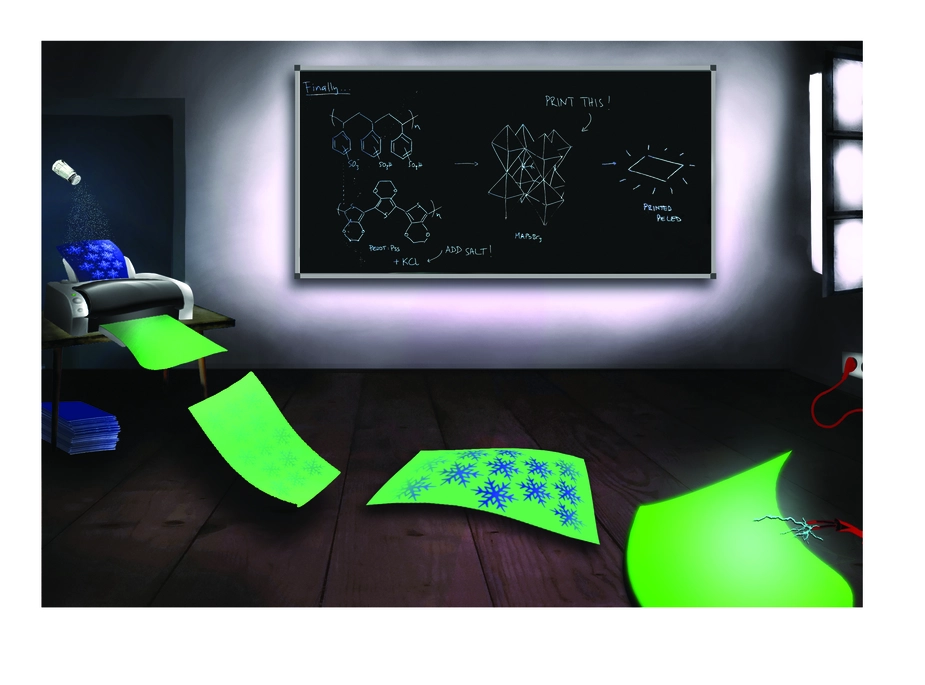First solar cells from an inkjet printer, now light-emitting diodes too
Team of HZB and HU Berlin succeeds in inkjet printing of perovskite LED
A team of researchers from the Helmholtz-Zentrum Berlin (HZB) and Humboldt-Universität zu Berlin has succeeded for the first time in producing light-emitting diodes (LEDs) from a hybrid perovskite semiconductor material using inkjet printing.This opens the door to broad application of these materials in manufacturing many different kinds of electronic components.The scientists achieved the breakthrough with the help of a trick: "inoculating" (or seeding) the surface with specific crystals.
Microelectronics utilise various functional materials whose properties make them suitable for specific applications. For example, transistors and data storage devices are made of silicon, and most photovoltaic cells used for generating electricity from sunlight are also currently made of this semiconductor material. In contrast, compound semiconductors such as gallium nitride are used to generate light in optoelectronic elements such as light-emitting diodes (LEDs). The manufacturing processes also different for the various classes of materials.
Transcending the materials and methods maze
Hybrid perovskite materials promise simplification – by arranging the organic and inorganic components of semiconducting crystal in a specific structure. “They can be used to manufacture all kinds of microelectronic components by modifying their composition“, says Prof. Emil List-Kratochvil, head of a Joint Research Group at HZB and Humboldt-Universität.
What's more, processing perovskite crystals is comparatively simple. “They can be produced from a liquid solution, so you can build the desired component one layer at a time directly on the substrate“, the physicist explains.
First solar cells from an inkjet printer, now light-emitting diodes too
Scientists at HZB have already shown in recent years that solar cells can be printed from a solution of semiconductor compounds – and are worldwide leaders in this technology today. Now for the first time, the joint team of HZB and HU Berlin has succeeded in producing functional light-emitting diodes in this manner. The research group used a metal halide perovskite for this purpose. This is a material that promises particularly high efficiency in generating light – but on the other hand is difficult to process.
“Until now, it has not been possible to produce these kinds of semiconductor layers with sufficient quality from a liquid solution“, says List-Kratochvil. For example, LEDs could be printed just from organic semiconductors, but these provide only modest luminosity. “The challenge was how to cause the salt-like precursor that we printed onto the substrate to crystallise quickly and evenly by using some sort of an attractant or catalyst“, explains the scientist. The team chose a seed crystal for this purpose: a salt crystal that attaches itself to the substrate and triggers formation of a gridwork for the subsequent perovskite layers.
Significantly better optical and electronic characteristics
In this way, the researchers created printed LEDs that possess far higher luminosity and considerably better electrical properties than could be previously achieved using additive manufacturing processes. But for List-Kratochvil, this success is only an intermediate step on the road to future micro- and optoelectronics that he believes will be based exclusively on hybrid perovskite semiconductors. “The advantages offered by a single universally applicable class of materials and a single cost-effective and simple process for manufacturing any kind of component are striking“, says the scientist. He is therefore planning to eventually manufacture all important electronic components this way in the laboratories of HZB and HU Berlin.
List-Kratochvil is Professor of Hybrid Devices at the Humboldt-Universität zu Berlin and head of a Joint Lab founded in 2018 that is operated by HU together with HZB. In addition, a team jointly headed by List-Kratochvil and HZB scientist Dr. Eva Unger is working in the Helmholtz Innovation Lab HySPRINT on the development of coating and printing processes – also known in technical jargon as "additive manufacturing" – for hybrid perovskites. These are crystals possessing a perovskite structure that contain both inorganic and organic components.
The work was published in Materials Horizons, the journal of the Royal Society of Chemistry, in an article entitled “Finally, inkjet-printed metal-halide perovskite LEDs – utilizing seed-crystal templating of salty PEDOT:PSS“ by Felix Hermerschmidt, Florian Mathies, Vincent R. F. Schröder, Carolin Rehermann, Nicolas Zorn Morales, Eva L. Unger, Emil J. W. List-Kratochvil. DOI:10.1039/d0mh00512f
Contact
Prof. Dr. Emil List-Kratochvil
Helmholtz-Zentrum Berlin
EE-GGP Generative Manufacturing Processes for Hybrid Devices
Email: EE-GGP-office(at)helmholtz-berlin.de
Humboldt-Universität zu Berlin
Institut für Physik | Institut für Chemie | IRIS Adlershof | AG Hybrid Devices
Brook-Taylor-Straße 6, 12489 Berlin
Tel. +49 30 2093-7697
www.hyd.iris-adlershof.de
Dr. Eva Unger
Young Investigator Group Hybrid Materials Formation and Scaling
Tel. +49 30 8062-13116
Email eva.unger(at)helmholtz-berlin.de
HZB Press Office
Dr. Ina Helms
Email: ina.helms(at)helmholtz-berlin.de
Source: Press release HZB / Author: Ralf Butscher
